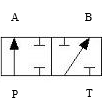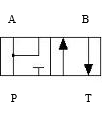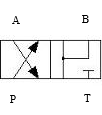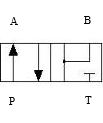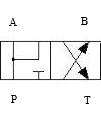4-Way 2-Position Directional Valve (IL)
Libraries:
Simscape /
Fluids /
Isothermal Liquid /
Valves & Orifices /
Directional Control Valves
Description
The 4-Way 2-Position Directional Valve (IL) block models a valve with four openings — such as the valves between an actuator, pump, and tank — in an isothermal liquid network. The valve operation is controlled by a single spool displaced according to the signal at port S. You can set the baseline configuration of your valve by specifying the orifices that are open when the spool moves in the positive direction and negative directions in the Positive spool position open connections and Negative spool position open connections parameters, respectively. You can set the valve opening model in the Orifice parameterization parameter as a linear relationship or function of user-provided data, which you can apply to one or all flow paths in the valve.
This block is a composite component that comprises of multiple instances of the Orifice (IL) block. Refer to the Orifice (IL) block for more details about the valve parameterizations and block calculations. In some configurations, this valve resembles a 3-way valve. To set additional flow paths when the spool is in the neutral position, see the 4-Way 3-Position Directional Valve (IL) block.
This image shows an example valve setup where the valve is connected to a tank, actuator,
and pump and the Positive spool position open connections parameter
is P-B, A-T:

This image shows the valve when the Negative spool position open
connections parameter is P-A, B-T:

In this configuration, when the signal at port S moves the spool to a negative position, the paths between ports P and A and between ports B and T are open to flow. The paths between ports P and B and ports A and T are closed to flow.
This image shows the valve when the Positive spool position open
connections parameter is P-B, A-T:
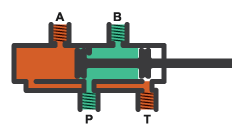
In this configuration, when the signal at port S moves the spool to a positive position, the paths between ports P and B and between ports A and T are open to flow and the paths between ports P and A and between ports B and T are closed.
The schematic that represents this configuration is:
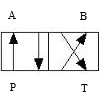
The left-hand side corresponds to the positive position and the right-hand side corresponds to the negative position. The valve transitions through positions in the neutral mid-section.
Spool Displacement and Valve Configuration
The spool stroke is the amount of spool travel an orifice takes to fully open from a closed position. You can use the Orifice parameterization and Area characteristics parameters to specify the flow path characteristics:
| Orifice Parameterization | Identical for All Flow Paths | Different for Each Flow Path |
|---|---|---|
Linear - Area vs. spool
travel | The Spool travel between closed and open orifice parameter defines the spool stroke | The Spool travel between closed and open orifice parameter defines the spool stroke for each orifice |
Tabulated data - Area vs. spool
travel | The difference between the first and last element of the Spool travel vector parameter defines the spool stroke | The difference between the first and last element of the Spool travel vector parameter for each orifice |
Tabulated data - Volumetric flow rate vs. spool
travel and pressure drop | The difference between the first and last element of the Spool travel vector, ds parameter defines the spool stroke | The difference between the first and last element of the Spool travel vector, ds parameter defines the spool stroke for each orifice |
The direction of the spool movement depends on the spool stroke, orifice orientation, and signal at port S. This table shows the spool travel for an orifice depending on the selections for the Positive spool position open connection and Negative spool position open connection parameters:
| Spool Position When Orifice Is Open | Spool Travel, ΔS |
|---|---|
| Orifice always closed: orifice not selected for the Positive spool position open connection or Negative spool position open connection parameters | N/A |
| Orifice always open: orifice selected for both the Positive spool position open connection and Negative spool position open connection parameters | N/A |
| Negative: orifice selected for only Negative spool position open connection parameter | Sorifice_max + spool stroke – S |
| Positive: orifice selected for only Positive spool position open connection parameter | Sorifice_max – spool stroke + S |
Where Sorifice_max is the spool position at the maximum orifice area defined for each orifice. The orifice area saturates at the leakage area when ΔS is negative and saturates at the maximum orifice area when the orifice is fully open. When the orifice is fully open, ΔS is equal to the spool stroke, so ΔS greater than the spool stroke does not further increase the orifice area.
This table shows the possible configurations of the 4-Way 2-Position Directional Valve (IL):
| Configuration | Parameter Values |
|---|---|
All four paths are closed during transition. |
|
All four paths are open during transition. |
|
A-T and B-T are closed during transition. |
|
P-A and P-B are closed during transition. |
|
P-B and B-T are closed during transition. |
|
P-A and A-T are closed during transition. |
|
P-A, P-B, and B-T are open during transition. |
|
P-A, A-T, and B-T are open during transition. |
|
P-A and P-B are closed during transition. A-T is always closed. |
|
All paths are closed during transition. |
|
A-T is open during transition. P-A is closed during transition. |
|
B-T is open during transition. P-B is closed during transition. |
|
P-A is closed during transition. |
|
P-B is closed during transition. |
|
Valve Orifice Parameterizations
The Orifice parameterization parameter specifies the model for the
open area or volumetric flow rate through one or all of the valve orifices. If you
set Area characteristics to Identical for all flow
paths, the block applies the same data for all flow paths. When
you select Different for all flow paths, the block uses
individual parameterizations for each flow path.
When Orifice parameterization is Linear - area
vs. spool travel, the opening area is a linear function of the
spool position received as a signal at port S
where:
ΔS is the spool travel.
Aorifice saturates at Aleak when ΔS is negative and saturates at Amax when the orifice is fully open. When the orifice is fully open, ΔS is equal to the spool stroke, so a value of ΔS that is greater than the spool stroke does not increase the orifice area.
ΔSmax is the value of the Spool travel between closed and open orifice parameter.
Amax is the value of the Maximum orifice area parameter.
Aleak is the value of the Leakage area parameter.

When the valve is in a near-open or near-closed position in the linear parameterization, you can maintain numerical robustness in your simulation by adjusting the Smoothing factor parameter. If the Smoothing factor parameter is nonzero, the block smoothly saturates the opening area between Aleak and Amax. For more information, see Numerical Smoothing.
When Orifice parameterization is Tabulated data
- Area vs. spool travel, you can provide spool travel vectors for
your system or for individual flow paths between ports P,
A, B, and T. The
block uses this data to calculate the relationship between the orifice area and
spool displacement. The block uses interpolation to determine the opening area
between the data points. Aleak and
Amax are the first and last parameters
of the opening area vector, respectively.

When Orifice parameterization is Tabulated data
- Volumetric flow rate vs. spool travel and pressure drop, you can
provide spool travel and pressure drop vectors and a dependent, 2-D volumetric flow
rate array. The block uses interpolation to determine the flow rate between the data
points. The mass flow rate is the product of the volumetric flow rate and the local
density.

Visualize Orifice Openings
To visualize the spool offsets and maximum displacement, right-click the block and select Fluids > Plot Valve Characteristics. The plot shows the orifices specified by the parameters in Valve Configuration section. The axes are either:
Orifice Area verses Spool Position
Volumetric Flow Rate verses Spool Position, queried at a specific pressure differential
When you set the parameters in the Valve Configuration tab to the same orifice, the orifice opening is a constant.
Click Reload Data to update the data in the figure.
This image shows the default configuration for the block:
Positive spool position open connections is
P-A, B-T.Negative spool position open connections is
P-B, A-T.
All other spool positions are at the default values.
Example Spool Position Visualization

Faults
To model a fault, in the Faults section, click the Add fault hyperlink next to the fault that you want to model. Use the fault parameters to specify the fault properties. For more information about fault modeling, see Introduction to Simscape Faults.
The Spool position when faulted parameter has three fault options:
Positive— The spool position freezes in the positive position, opening the flow paths specified by the Positive spool position open connections parameter to their maximum value. The flow paths specified by the Negative spool position open connections parameter are closed.Negative— The spool position freezes in the negative position, opening the flow paths specified by the Negative spool position open connections parameter to their maximum value. The flow paths specified by the Positive spool position open connections parameter are closed.Maintain last value— The valve freezes at the spool position when the trigger occurs.
Due to numerical smoothing at the extremes of the valve area, in the linear parameterization, the minimum area that he block uses is larger than the Leakage area, and the maximum is smaller than the Maximum orifice area, in proportion to the Smoothing factor value. For more information, see Numerical Smoothing.
After the fault triggers, the valve remains at the faulted area for the rest of the simulation.
Predefined Parameterization
You can populate the block with pre-parameterized manufacturing data, which allows you to model a specific supplier component.
To load a predefined parameterization:
In the block dialog box, next to Selected part, click the "<click to select>" hyperlink next to Selected part in the block dialog box settings.
The Block Parameterization Manager window opens. Select a part from the menu and click Apply all. You can narrow the choices using the Manufacturer drop down menu.
You can close the Block Parameterization Manager menu. The block now has the parameterization that you specified.
You can compare current parameter settings with a specific supplier component in the Block Parameterization Manager window by selecting a part and viewing the data in the Compare selected part with block section.
Note
Predefined block parameterizations use available data sources to supply parameter values. The block substitutes engineering judgment and simplifying assumptions for missing data. As a result, expect some deviation between simulated and actual physical behavior. To ensure accuracy, validate the simulated behavior against experimental data and refine your component models as necessary.
To learn more, see List of Pre-Parameterized Components.

